Latino Blood, American Hearts
By Eddie Martinez
September 2021
The National Hispanic Heritage Month
Historically, nearly one-third of modern-day North America was ruled by Spain for over 300 years; stretching from Florida to Northern California, and from as far north from the Dakotas all the way south, beyond Texas. On September 16, 1810, the cleric Miguel Hidalgo y Costilla rang the church bell declaring the Cry of Dolores known as el Grito de Dolores, declaring Mexico’s Independence from Spain.
The Mexican War of Independence lasted for over a decade, until August 24, 1821, after the Spanish King, Ferdinand VII officially recognized Mexico as an independent country.
The United States of America officially designated September 15 to October 15 as National Hispanic Heritage Month, when President George H. W. Bush signed Presidential Proclamation 6021 on September 14, 1989.
Art Print, in celebration of the National Heritage Month
by Eddie Martinez
 Latino Blood, American Hearts, Art Print, size: 24” H x 36” W
Latino Blood, American Hearts, Art Print, size: 24” H x 36” W
This art print Latino Blood, American Hearts is a collage of illustrated campaign maps representing the heroic acts of valor fought by our brave Latino service members in the Military Services in defense of the United States of America.
The time frame of these military campaigns begins in the year 1775, at the launch of the American Revolutionary War (April 19, 1775 - September 3, 1778) and concludes in 2005 with Operation Desert Storm, when the U.S. was provoked by Iraq’s invasion and occupation of Kuwait.
Somos Primos’ Military Presentation to the National Archives in D.C.
Mimi Lozano, the editor of Somos Primos Online asked me to be one of the twelve Somos Primos lecturers to present one diverse topic each; one each month during the 2005 celebration of the National Hispanic Heritage Month in Washington, D.C.
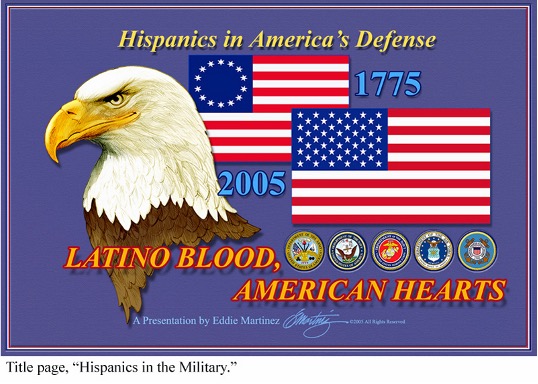
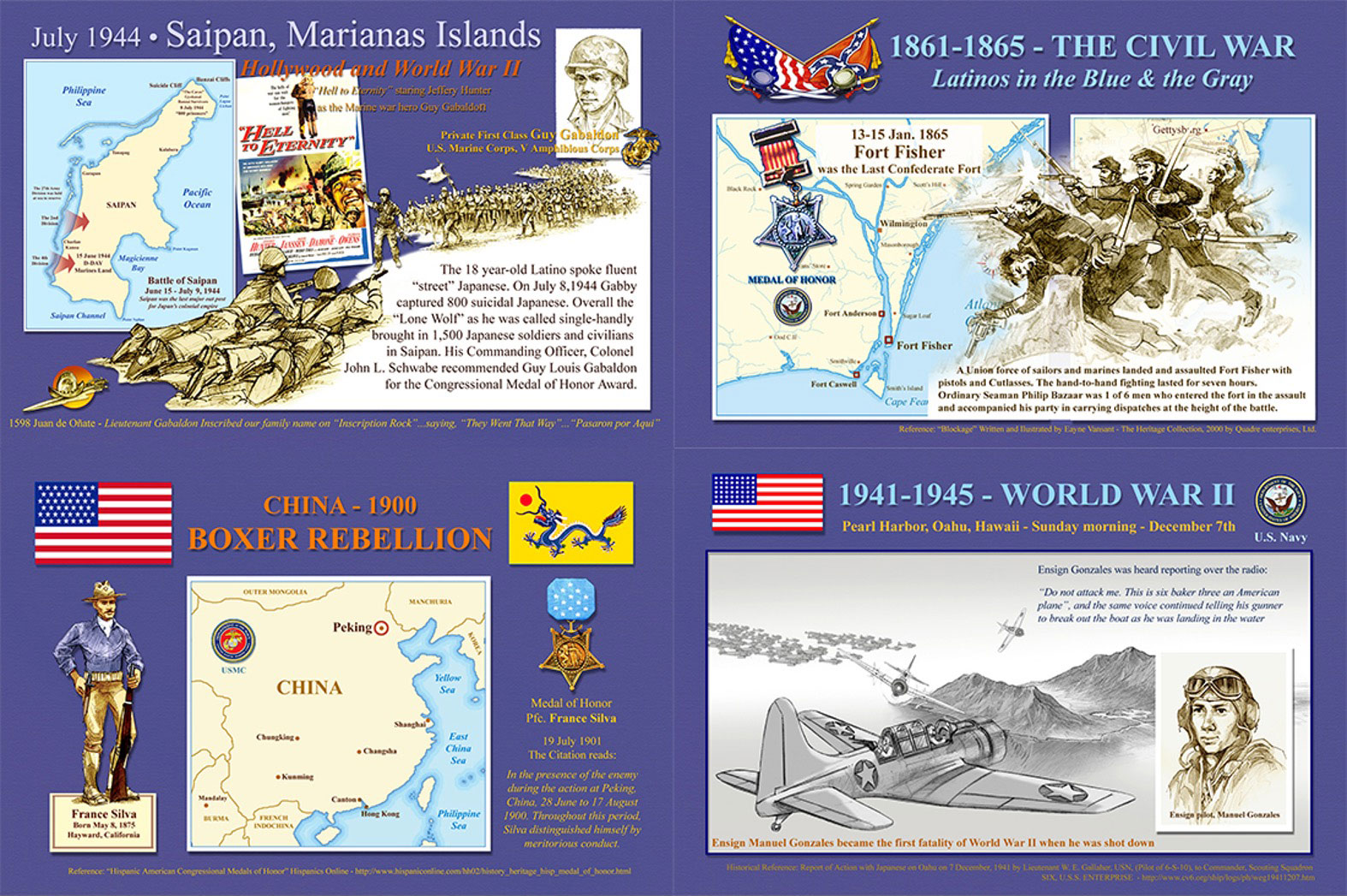
Sampling of the power-point presentation for the National Archives in Washington D.C.
I agreed to take on the topic, Hispanics in the Military; chiefly, because I was influenced and inspired after having read Raul Morin’s book, Among the Valiant: Mexican-Americans in WWII and Korea, prefaced with a note of approval by then, Vice President, Lyndon B. Johnson.
On October 12, 2005, after completing my work, I presented my illustrated PowerPoint essay at the Williams G. McGowan Theater in the National Archives in Washington D.C.
This is one of many military statistics I came across while researching Latinos in the Military:
39 Latino Americans received the Congressional Medal of Honor
1863-2002
Civil War
Sergeant Joseph H. De Castro (Boston, MA) 1863 U.S. Army
Regular Seaman John Ortega (Spain) 1864 U.S. Navy
Regular Seaman Philip Bazaar (Chile) 1865 U.S. Navy
China Relief Expedition/Boxer Rebellion
Private France Silva (Haywood, CA) 1901 U.S. Marine Corps
World War I
First Lieutenant David Barkeley Cantú (Laredo, TX) 1918 U.S. Army
World War II
Private Joe P. Martínez (Taos, NM) 1943 U.S. Army
Staff Sergeant Rudolph B. Dávila (El Paso, TX) 1944 U.S. Army
Staff Sergeant Lucian Adams (Port Arthur, TX) 1944 U.S. Army
Sergeant José M. López (Mission, TX) 1944 U.S. Army
Staff Sergeant Macario García (Mexico) 1944 U.S. Army
Private First Class Harold Gonsalves (Alameda, CA) 1945 U.S. Marine Corps
Private First Class David H. Gonzales (Pacoima, CA) 1945 U.S. Army
Private First Class Silvestre S. Herrera (El Paso, TX) 1945 U.S. Army
Private First Class Manuel Pérez, Jr. (Oklahoma City, OK) 1945 U.S. Army
Technical Sergeant Cleto Rodríguez (San Marcos, TX) 1945 U.S. Army
Private First Class Alejandro Rentería Ruiz (Loving, NM) 1945 U.S. Army
Private First Class José F. Valdez (Governador, NM) 1945 U.S. Army
Staff Sergeant Ysmael R. Villegas (Casa Blanca, CA) 1945 U.S. Army
Korean War
First Lieutenant Baldomero López (Tampa, FL) 1950 U.S. Marine Corps
Private First Class Eugene A. Obregón (Los Angeles, CA) 1950 U.S. Marine Corps
Private First Class Edward Gómez (Omaha, NE) 1951 U.S. Marine Corps
Corporal Rodolfo P. Hernández (Colton, CA) 1951 U.S. Army
Sergeant Joseph C. Rodríguez (San Bernardino, CA) 1951 U.S. Army
Corporal Benito Martínez (Fort Hancock, TX) 1952 U.S. Army
Private First Class Fernando Luis García (Utuado, PR) 1952 U.S. Marine Corps
Staff Sergeant Ambrosio Guillén (La Junta, CO) 1953 U.S. Marine Corps
Vietnam War
Specialist Fourth Class Daniel Fernández (Albuquerque, NM) 1966 U.S. Army
Specialist Fourth Class Alfred V. Rascón (Chihuahua, Mexico) 1966 U.S. Army
Captain Eurípides Rubio (Ponce, PR) 1966 U.S. Army
Private First Class Carlos James Lozada (Caguas, PR) 1967 U.S. Army
First Sergeant Máximo Yabes (Lodi, CA) 1967 U.S. Army
Major Jay R. Vargas, Jr. (Winslow, AZ) 1968 U.S. Marine Corps
Master Sergeant Roy P. Benavídez (El Campo, TX) 1968 U.S. Army
Sergeant Alfredo Gonzales (Edingurge, TX) 1968 U.S. Marine Corps
Specialist Fourth Class Héctor Santiago-Colón (Salinas, PR) 1968 U.S. Army
Lance Corporal José Francisco Jiménez (Mexico) 1969 U.S. Marine Corps
Lance Corporal Emilio A. De la Garza, Jr. (Chicago, IL) 1970 U.S. Marine Corps
Lance Corporal Miguel Keith (San Antonio, TX) 1970 U.S. Marine Corps
Warrant Officer Louis R. Rocco (Albuquerque, NM) 1970 U.S. Army
Eddie Martinez in the United States Air Force

As a teenager, I joined the Air Force where I served from July 1954 until April 1958. After completing my term of four years, I received the National Defense Service Medal, the Good Conduct Medal, and was Honorably Discharged in McCord Air Force Base (AFB), Tacoma, Washington.
After I graduated from Basic Training at Lackland AFB in San Antonio, Texas and was given leave to visit San Antonio. I enjoyed seeing the sights, walking along the River Walk and visiting The Alamo Museum. Intending to see more, I climbed aboard a bus and after paying the driver I turned to walk down the aisle, I was surprised to see a sign posted atop a seat, stating, “Whites Only.” Not knowing where I should sit, I chose to walk to the rear and sit at the back of the bus.
In 1956, after having served for two years as a Specialist/Aircraft Dispatcher at Ellington AFB in Houston, Texas, I was reassigned to the 449th Fighter Interception Squadron at Ladd AFB in Fairbanks, Alaska.
Now I was a dispatcher of F-89D jet fighters. My duty was to standby to receive calls from Radar on my red-colored telephone that flashed a red light when it rang. When I answered it, a radar observer would instruct me to dispatch two fighter jets to intercept an incoming unidentified aircraft that was approaching our airspace. Normally the unidentified was a friendly that either had a radio malfunction or was running late on its scheduled Flight Plan.

Cartoon rendering by Eddie Martinez of the 449th Fighter Interceptor Squadron, Galena, Alaska
A year later in 1957, the 449th was transferred to a remote site along the Yukon River, in a newly constructed Air Force runway in Galena, Alaska. It was located approximately halfway between Fairbanks and Nome; moving our unit 250 miles further west, positioning the United States’ first line of defense closer to the Soviet Union during the time of the Cold War.
My workstation in Galena was in a glass box placed on top of the aircraft hangers, where I had an unobstructed 180° view of the entire length of our two runways, with a control tower centrally located behind both runways. My communications consisted of a red-alert phone, a handheld UHF & VHF, and a squawk-box allowing me to communicate directly with the radar operator, the control tower, the pilots aboard their aircrafts, and the flight hanger below.
This workstation on the upper floor of the flight hanger opened to the adjoining officer's quarters that was furnished with bunkbeds, tables and chairs, and a full kitchen. The space between us had a large blackboard mounted on the wall where I would post the fighter jets designated as ‘Sandy 1’ and ‘Sandy 2’ that were on standby ready to be ‘scrambled’.
In the center of the floor was a circular hole with a brass pole so that the pilots could slide down below to the airplane hangar, allowing the pilots to be airborne ASAP. Five minutes was the time allotted; from the call to scramble to be airborne. Our fastest time was 3 minutes.
One day our airborne time was completely shattered, I know because I was on duty that day. It all began when the standby pilots were changing shifts. The ‘Sandy’ pilots going off-shift wanted to get some air time for their flight record so I erased their designation from ‘Sandy One’ and ‘Sandy Two’ to “Orange One” and ‘Orange Two” and as they walked downstairs to get in their planes, I began writing in the new pilots on five-minute standby.
All of the sudden, the Red Phone lit-up ringing. I quickly ran over and picked it up to hear the radar operator say, “Scramble Two!”
I answered, “Roger!”
Taking in my situation, that I have two pilots on standby upstairs and two pilots in their planes ready to take off downstairs - I made a quick decision to notify Control Tower to standby while I reassigned and notified the pilots already in the hanger that their new Call Sign was Sandy One and Sandy Two. This allowed the pilots already in the hanger to respond in a timely manner.
I swiftly announced to all, “Sandy One and Two, Scramble!”
The pilots both answered, “Roger Tower!” and with that they powered up their engines to to one-hundred-percent, roaring so loud it shook the hanger, panicking all of the startled pilots who began running into my small glass booth wanting to know what was happening.
By then we were all starring in fascination watching and hearing the two fighter pilots roar out of the hanger and go zooming down the icy taxi-strip neck as they smiled, looking at each other as they raced to reach their assigned runways.
Then our squadron commander, Major James C. Perry, shouldered his way into the control room hollering, “What the hell’s going on Eddie!?”
As I was scribbling down times, names, and communications for my report, I responded to my commander saying, “Sir, I’ll be with you as soon as they’re off the ground!” By now Major Perry was fixed on watching the scrambled planes as he nodded his acceptance.
Concurrently, the two fighter pilots were about to reach their runways. As though in tandem, they both hit their left brakes and began skidding around, then both kicked-on their afterburners; and with those two large booming explosions, that catapulted the fighter jets lifting them off the ground flying straight up into the night sky, as I clocked their takeoff.
Then Perry looked at me and asked, “What’s the Takeoff Time, Martinez?”
I answered, “Zero, Major Perry!”
We both smiled broadly as Perry said, “Good job, Eddie!”
Note on the Cold War: President Harry S. Truman signed the Truman Doctrine on March 12, 1947 which prevailed until it dissolved after the ousting of Nikita Khrushchev by his colleagues in 1964.
Andrews Air Force Base Art Gallery, Maryland
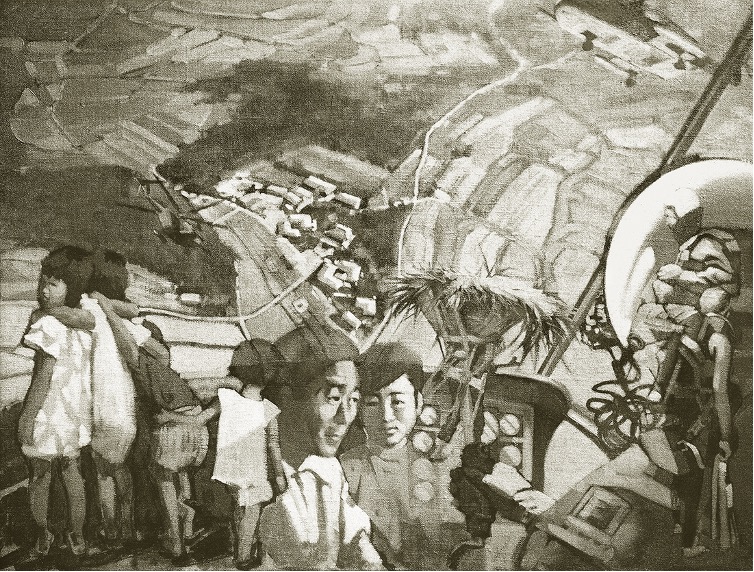
The United States Air Force maintains a cooperative art program with the Societies of Illustrators in Los Angeles, CA. On June 8, 1971, I received a letter from the Department of the Air Force in Washington, DC, under special order TA-1180 from the Secretary of the Air Force, Chief of Staff, General John D. Ryan, inviting me to proceed on June 15, 1971, to Air Forces Bases in Asia that included South Korea, Okinawa, and other destinations in Japan for eleven days. This invitation retained me to the equivalent of a GS-15.
I departed Travis AFB on the 15th of June and arrived in Yokota Airbase (AB) on the 17th of June. On the 21st of June, I departed Japan and flew to Okinawa and arrived in Kadena AB. The following day I flew to South Korea and arrived at Kunsan AB at 10:30 PM.
On the 23rd of June, at 6:30 AM, a captain drove me on a jeep from Osan AB to survey the demilitarized zone (DMV Zone) protected by the South Korean ROCAF Army. The DMV Zone was a perimeter protected by barbed-wire and boobytraps alongside the Yellow Sea.
Early on the following morning, I was riding on a jeep escorted by two sergeants who told me to remain in the jeep until we arrived at our destination. After a two and a half-hour jarring, potholed, jolting ride on a mucky road, we arrived at the Osan AFB firing range in Koon-ni where I observed Air Force F-4 fighters carry out their firing and bombing runs at assigned targets.
On my return to Osan AFB, I refused to ride back on the jeep, so the office made arrangements for me to return aboard a rescue helicopter, tagged The Jolly Green Giant. During the return flight I spoke to Staff Sgt. John Barrio who said his training included, treating injuries, mountain climbing, snow skiing, parachuting, scuba diving, and firing machine guns, in order for him to qualify as an Air Force paramedic. Fascinated, I expressed my interest in knowing more about his rescue operations. Replying, Barrio told me his unit was having preparedness exercises tomorrow.
Bright and early on the following morning on the 25th of June, I was flying aboard the Jolly Green Giant sitting next to Paramedic S/Sgt. John Barrio, when he asked me to stand up and gave me a body harness to put on. Once on, he checked to make sure it was secure. Then he linked two canvas straps to rings on both sides of my waist and coupled them to the left and right of large open door of the choppers. Once I was securely fastened, he tapped me on my shoulder and yelled over the roar of rotary with a big smile yelling, “You won’t fall out so have fun observing the rescue maneuvers!”
I was elated, with the wind in my face I began snapping pictures with my 35mm Nikon of the network of mired rescue exercises that lasted the entire day, all the while I was enjoying my awesome experience, literally hanging out of the large open door of the chopper taking photographs affirming my theme for the Air Force painting.
On June 30, 1971, I departed Tokyo, Japan and arrived in Travis AFB on the same day.
A Novel based on Spanish America and the Revolutionary War
By Eddie Martinez
I am presently writing an illustrated novel based on the true-life adventures of Spanish General Bernardo de Gálvez, his uncle, Inspector General of Spanish America José de Gálvez, and his father, Matías de Gálvez, that took place during the American Revolutionary War.
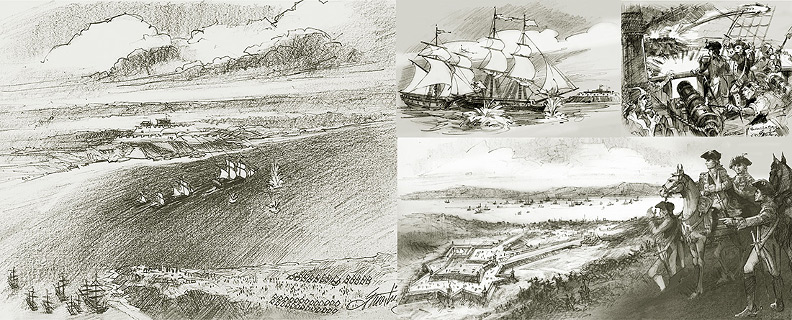
Preliminary Storyboard Sketches for novel
I began researching the life and times of the intrepid Bernardo de Galvez in 2005. Since then, I have continued reading material based on his life. I found these three books totally enlightening:
1) The Longest Siege of the American Revolution: Pensacola by Wesley S. Odom;
2) Bernardo de Gálvez’ written account, Bernardo de Galvez’ Diary of The Operations Against Pensacola;
3) and what I believe to be the most definitive chronicle on the life of the Gálvez family and Spain’s war against Great Britain, Spain and the Independence of the United States: An Intrinsic Gift by Thomas E. Chávez, PhD.

#3 Spain and the Independence of the United States: An Intrinsic Gift by Tom Chávez
In the beginning of my research on the life of Bernardo de Gálvez, I came across these accounts written by Dr. Tomas Chávez on Bernardo de Gálvez: Hispanics in the American Revolution and Spain's Support Vital to U.S. Independence.
Later I read his illuminating book, Spain and the Independence of the United States: An Intrinsic Gift. After my research, I was able to meet Dr. Chávez in Albuquerque, New Mexico to share my sketches and drawings with him to discuss his interesting accounts on the Gálvez family in Spanish America.
We continued to communicate via e-mails where I would ask him questions and send him my sketches related to his writing. His information and suggestions were invaluable to me. I was so taken by that informative exchange that I felt if I could tell the story in the format of an illustrated novel it would go a long way to humanize those historical events and actions in an entertaining and informative way.
Additionally, I recommend reading these other three books
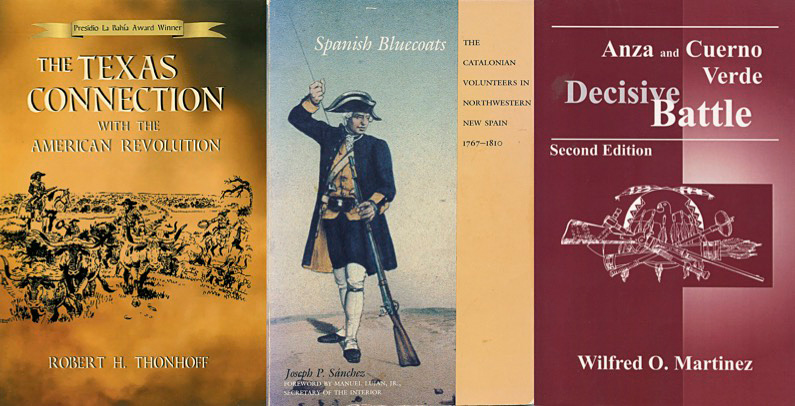
Three Books, Lt. to Rt., #1 Cowboys; #2 Soldiers, #3 De Anza
The first book is, The Texas Connection with the American Revolution by Robert H. Thonhoff.
I found it to be very compelling because I’ve always had an interest in the real history of Tejas and the original cowboys, the Tejano vaqueros, their connection in support of the Governor of Spanish Louisiana, Bernardo de Gálvez, and the establishing of the supply network to General Gorge Washington’s colonial army.
I began communicating with Thonhoff via e-mails in 2005 when I was researching my power-point presentation for the National Archives. Thonhoff was very cordial and helpful by reviewing my written accounts, maps and sketches on Texas during the Revolutionary War. In time after my return from my Bernardo de Gálvez research trip, which I took in the south that included: Savanna, Georgia; St. Augustine and Pensacola, Florida; Mobile, Alabama; New Orleans, Louisiana; and San Antonio, Texas, I was finally able to meet Thonhoff.
The second book is, Spanish Bluecoats: The Catalonian Volunteers in Northwestern New Spain 1767-1810 by Joseph P. Sánchez.
This book was invaluable for me because it’s all encompassing in describing their history, their uniforms, their deployment to the presidios in Sonora, and their establishing of their presidios in Alta California.
After reading his book, I went to the University of New Mexico in Albuquerque and visited the Zimmerman Library and met Joseph P. Sánchez, PhD in his office. Sánchez is the founder and director of the Spanish Colonial Research Center. He was very courteous in listening to my interest in illustrating the expeditions and military campaigns of the Blue Coats. After reviewing my sketches and drawings of Bernardo de Gálvez and the Catalonian soldiers’ uniforms and weapons, I shared with him the costume clothing that were worn by the Spanish settlers and noblemen. The meeting was fruitful for me because of his encouragement to continue my work.
The third Book is, Ana and Cuerno Verde: Decisive Battle by Wilfred O. Martinez.
He portrays notable insight into the character of Juan Bautista de Anza along with his father and grandfather when he was fighting Apache warriors in the Spanish northern frontiers of the Sonora desert, and in western Texas as captain and commander of the Soldados de Cuera.
The majority of his historical accounts take place in Pueblo, Colorado and Santa Fe, New Mexico when he was Governor-General determined to defeat the Comanches and their warrior chief, his heated adversary, Cuerno Verde, from the Northern frontiers in Sonora. His mission in Santa Fe was to assemble an army and track-down Cuerno Verde’s whereabouts in northern Colorado and to defeat his Comanche army and kill him. More importantly, was his extensive account of De Anza’s successive battle against Cuerno Verde.
Ultimately, I was able to meet with Martinez in his home in Pueblo, Colorado. We became friends and began communicating via e-mails to further allow me to illustrate his written description of the decisive battle between Anza and Cuerno Verde. One of the things I found interesting when we were communicating back and forth, one of Wilfred Martinez emails he asked me if I knew of a Disney artist named Xavier Atencio who was born in Walsenburg, Colorado.
I answered, yes, saying that we had worked together on a number of projects. Wilfred Martinez was happy to hear that he was the same X Atencio from Walsenburg who went on to become a famous Walt Disney artist.
Contact Eddie Martinez:
E-Mail: eddiemart1512@gmail.com
Website: dancingstarstudio.com
Linkedin: linkedin.com/in/eddie-martinez-293b9941/
